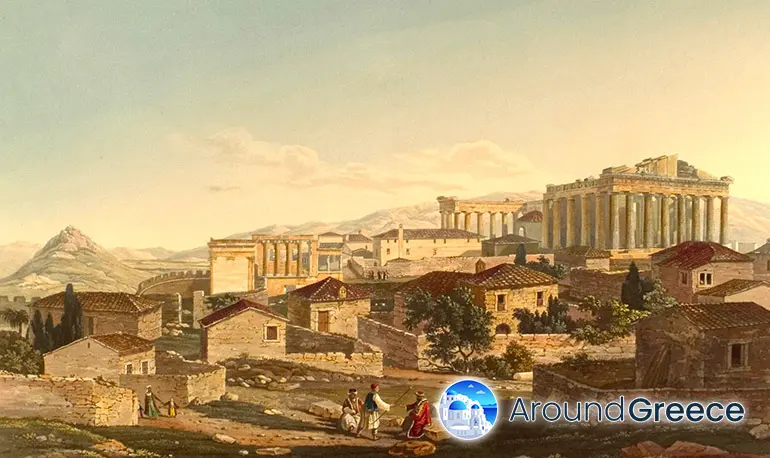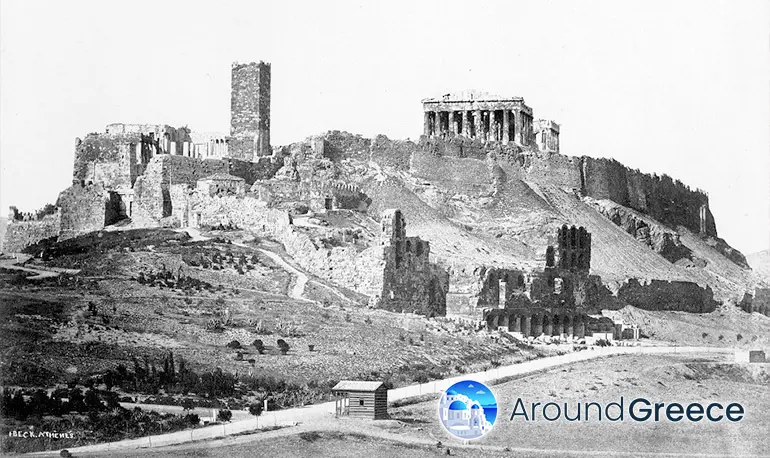Other Structures and Buildings
In ancient times there were several other buildings and structures built on the Acropolis, though there are only fragments of them remaining today.

On passing through the Propylaea, on the right hand side (south side), one would have seen the “Shrine of Artemis Brauronia”, which was built in the 6th century B.C. by Peisistratos. Next to this was the “Khalkotheke”, which could be described as a store room, where offerings were kept.
Another building that barely remains is the Old Temple of Athena, which was located just to the south-west of the Erechtheion. There are also remains of a sanctuary that was dedicated to Zeus, that are situated to the east of the Erechtheion. The Romans later built an Ionic circular temple next to this, which was dedicated to Roma and Augustus. The remains of this Roman temple can be pointed out by the few remaining columns that still stand.
For nearly a thousand years, the temples on the Acropolis, and in particular, the Parthenon survived without change, apart from some small Roman amendments. It was not until the reign of Emperor Justinian that major changes took place. Under his command, the temples were converted in order for Christian worship.
The Parthenon was converted into a Christian Church. During the conversion, the interior columns and some walls of the cella, were subsequently removed. This also led to the removal of many of the sculptures and decoration. In particular, those that depicted pagan Gods, would have been deliberately removed and destroyed.
During the following years, the Acropolis and it's temples would have been used for several religious and well as secular uses. During this, much of the classical designs, that had previously stood the test of time, would have gradually degraded.
When Greece fell to the Ottomans in 1456, the Parthenon was converted into a mosque, after already having been converted from a Greek and Roman temple, and a Frankish cathedral. The antiquities of Athens were not willingly destroyed by the Ottomans, as they were generally respectful of ancient monuments in their territories. However, they did not actually have any programme or desire to protect them either.
Though the number of changes forced onto the Parthenon and the other temples of the Acropolis seem vast, there general appearance and structure would not have been altered too much beyond recognition of the time when they were being designed. However, over time, war took it's toll, and there began the slow destruction of this once mighty great complex.
Several of the buildings on the Acropolis were blown up by the Venetians, who were fighting to oust the Turks. The Turks themselves demolished the “Temple of Nike” in 1684, in order to gain a short tactical advantage.
Gunpowder, stored by the Turks in the Parthenon was ignited by a Venetian shell. The subsequent explosion blew the roof off the Parthenon, and a fire subsequently spread through the complexes of the Acropolis for two whole days. The south side of the Parthenon suffered particular damage, with many columns collapsing, along with many of the sculptures and pieces of priceless art. It was after this, that the Parthenon was no longer used.
It was not until the 18th Century that looting of treasures from the Acropolis began on a large scale. The French ambassador Fauvel began collecting pieces for the Lourve, as did Lord Elgin, who was probably the biggest criminal in terms of the looting and removal of artifacts from the Acropolis and Parthenon.
Elgin, who was the British Ambassador in Constantinople, had gained permission from the Turks to make casts and drawings of the antiquities, as well as to erect scaffolding and to remove any stones with inscriptions on them. However, he did a little more than that, and started removing almost all of the friezes on the Parthenon, as well as removing an entire caryatid from the Erechtheion. Most of this was later sold to the British Museum, where, unfortunately for visitors to Athens, you will have to visit London to see these beautiful creations and works of art in all of their glory.
After the War of Independence, the Greeks regained control of the buildings and structures on the Acropolis. There was a desire to remove and clean up anything that was not classical. One of the first things cleared was the Turkish villlage that had been constructed around the Parthenon (when it was being used as a mosque).

However, much of this early clean up and restoration work that was done in fact caused more damage than was intended. Supports and clamps that were used to reinforce the marble columns and structures were ones that had not been covered in lead. This led to rust and bending, causing much of the marble and stones to start cracking.
In recent years, most of the damage caused to the Parthenon and other Acropolis structures has been caused by sulphur dioxide, mainly from car exhausts and factory immissions. This has slowly been turning the marble to dust. A rescue campaign for the preservation and renovation of the Parthenon and other structures on the Acropolis started in 1977. Since 1975, visitors were barred from actually entering the Parthenon and other temples, and these are now cordoned off.
The historian and architect Manolis Korress is in charge of the renovation work, which carries on today. The work itself is a very delicate operation, with parts of the temples and buildings being repaired brick for brick and stone for stone from the existing stones and ruins found on the site. In other cases, marble from Mount Penteli is also being used, as it is the same marble used by Pericles in the completion of the Parthenon and other temples in ancient times.
Though the Parthenon was originally completed in only 9 years, the work for it's preservation and restoration has, and will ultimately, take much longer than that. In the long term, the hard and meticulous work will be worth it, as it will ensure that this mighty and historical complex will be around and in good shape for people to see and admire for many generations to come.